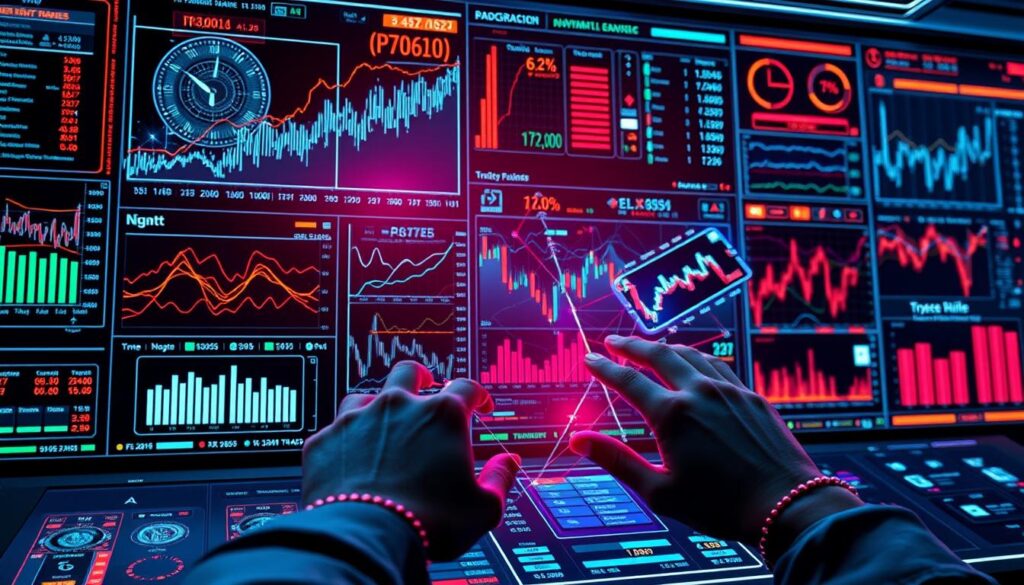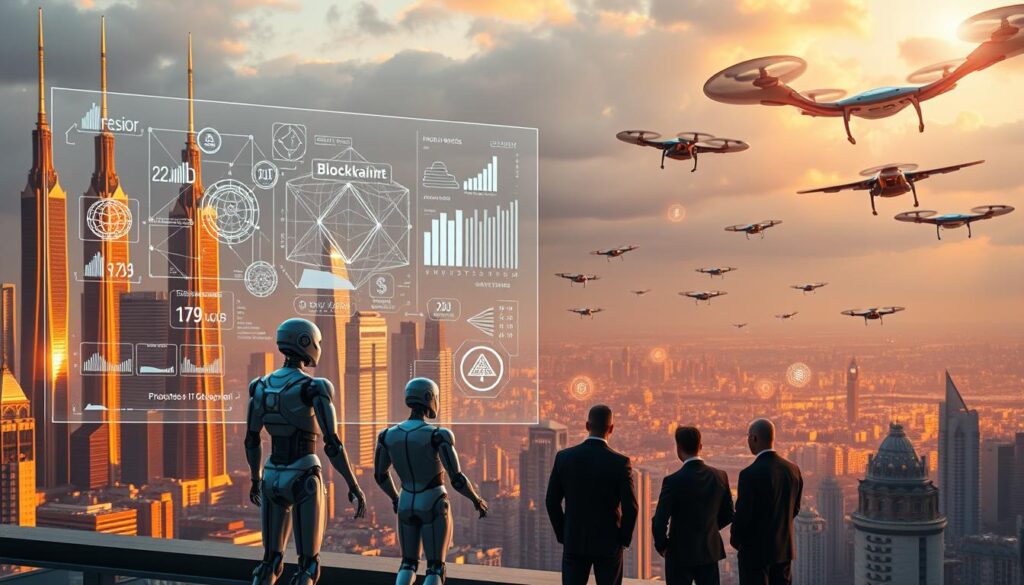Discover the Synergy of AI and Cryptocurrency
In late 2021, the cryptocurrency market hit $2.5 trillion. AI in finance is expected to grow 23.37% annually until 2027. This growth shows how artificial intelligence and cryptocurrency are becoming key tools in finance.
Now, over 200 million cryptocurrency wallets exist. AI trading bots can make trades 10 times faster than humans. This shows the real impact of combining AI and Crypto.
Blockchain’s security and AI’s predictive power are coming together. They aim to solve problems like fraud, scalability, and energy use.
The mix of artificial intelligence and cryptocurrency tackles major issues. AI can reduce crypto fraud by 80% and cut blockchain’s energy use by 40%. DeFi platforms using AI might grow 45% each year.
But, there are challenges like scalability and regulation. This article looks at how AI is changing blockchain’s future. It covers fraud detection and supply chain transparency, with examples like IBM’s blockchain projects.
The EU’s new AI Act means stricter rules. The future needs to balance innovation with responsibility.
Key Takeaways
- Cryptocurrency’s $2.5 trillion market cap shows its global appeal.
- AI in finance is set to grow 23.37% yearly until 2027.
- AI tools can cut crypto fraud by up to 80% and speed up trading by 50%.
- DeFi platforms using AI could grow 45% annually.
- Blockchain and AI together aim to reduce crypto mining energy use by 40%.
The Evolution of AI & Cryptocurrency Technologies
Technological changes rarely happen alone. Artificial intelligence and cryptocurrency have grown together, creating a future where they change industries together.
The Rise of Artificial Intelligence in Modern Technology
AI has grown fast from simple algorithms to advanced systems. ChatGPT and Midjourney show AI’s role in creative and analytical tasks. Now, AI powers healthcare and self-driving cars.
Cryptocurrency’s Journey from Bitcoin to Diverse Digital Assets
Bitcoin started in 2009. By 2010, someone used 10,000 BTC for two pizzas, showing its early value. Now, we have NFTs, DeFi, and AI coins like SingularityNET (AGIX). These changes show a move from simple transactions to complex systems.
| Year | AI Milestones | Crypto Milestones |
|---|---|---|
| 2009 | Early machine learning frameworks | Bitcoin’s whitepaper and launch |
| 2017 | Deep learning breakthroughs | Ethereum’s smart contracts debut |
| 2020 | First GAN-powered art sales | DeFi platforms rise to $10B market cap |
| 2023 | Large language models dominate | NFTs redefine digital ownership |
Convergence Points: When Two Revolutionary Technologies Meet
When blockchain meets AI, new chances appear. Cortex runs AI on blockchains, making it safer. Numerai and Worldcoin use AI in crypto trading and identity checks. The table below shows where they meet:
“Autonomous economies managed by AI and blockchain will soon reshape resource allocation,” predicts AI pioneer Ray Kurzweil.
These technologies are now coming together. They promise better efficiency, transparency, and innovation in many fields.
Understanding AI & Crypto Integration: A Comprehensive Overview
AI & Crypto Integration combines blockchain technology integration with AI to solve complex challenges. Projects like Ocean Protocol and The Graph bridge decentralized systems with machine learning tools. This synergy enhances security, data access, and automation in crypto ecosystems.
Core technologies driving this fusion include Zero-Knowledge Proofs (ZKPs) for privacy, Multi-Party Computation (MPC) for secure collaboration, and Fully Homomorphic Encryption (FHE) for data privacy during computations. These tools ensure data integrity without sacrificing security.
| Technology | Description | Use Case |
|---|---|---|
| Zero-Knowledge Proofs (ZKPs) | Verify data authenticity without revealing details | Secure crypto transactions |
| Multi-Party Computation (MPC) | Share data across networks without centralized control | Decentralized AI training |
| Fully Homomorphic Encryption (FHE) | Process encrypted data without decryption | Private blockchain analytics |
Platforms like Akash Network lease GPUs at 44% average utilization, cutting costs by up to 80% compared to AWS. Projects such as dKargo use AI to optimize supply chains via blockchain, while SingularityNET leverages AGIX tokens to power AI tool sharing. These systems merge AI’s predictive power with blockchain’s transparency.
Applications span automated trading, fraud detection, and DeFi tools. For instance, The Graph uses GRT tokens to index blockchain data for AI analysis. This blend of technologies creates scalable solutions for industries from finance to healthcare.
How Artificial Intelligence is Transforming Blockchain Networks
Blockchain and This mix tackles long-standing issues in security, efficiency, and growth. It uses advanced algorithms and data analysis.
Now, blockchain technology integration with AI boosts security. AI checks transaction patterns to spot odd activity, cutting fraud by up to 40%. IBM uses AI to watch blockchain networks, finding weaknesses before they’re used.
AI-Enhanced Security Protocols for Blockchain
- Machine learning models analyze historical data to predict attack vectors
- Automated threat detection systems reduce human error in security audits
- Zero-knowledge proofs combined with AI ensure privacy without sacrificing transparency
Smart Contract Optimization Through Machine Learning
Traditional smart contracts can be slow and prone to mistakes. AI makes them better by learning from past data, speeding up processing by 60%. IPwe’s Global Patent Registry uses AI to check terms automatically, making sure everything is right and reducing arguments.
Consensus Mechanisms Reimagined with AI Algorithms
Old methods like Proof of Work are slow and use a lot of energy. AI algorithms, like those in Hyperledger Fabric, change rules on the fly. This balances speed and safety, saving energy and handling 10x more transactions per second.
These changes show AI is more than just a tool—it’s the heart of blockchain’s future. As artificial intelligence and cryptocurrency systems get better, more businesses will use them. This will open up new uses in finance, healthcare, and supply chains.
Automated Trading Systems: The Marriage of AI and Cryptocurrency Markets

Automated trading with cryptocurrencies is changing financial markets with AI. Systems using machine learning for cryptocurrency trading handle 70% of global crypto trades. They make decisions faster than humans, thanks to analyzing trends and data.
Predictive Analytics for Crypto Trading Strategies
Machine learning models use decades of data to predict trends. Platforms like Fetch.ai and Virtuals Protocol use AI algorithms for crypto market analysis with up to 90% accuracy. They analyze news and data to find opportunities before humans do.
Risk Management Through AI-Poweredd Market Analysis
AI systems manage risk by simulating scenarios and adjusting strategies. They calculate the best trade sizes and set stop-losses. Studies show these tools reduce errors by 30% and catch fraud attempts in real time.
Case Studies: Successful AI Trading Bots
“Our AI agents execute 10,000 trades daily with 98% accuracy,” says Injective Labs, developers of the Smart Agent Hub. Their system, integrating OpenAI’s models, optimizes trades across 10+ blockchains. Early tests show ROI increases of 25% for users adopting these systems.
As AI tools like Injective’s Smart Agent Hub prepare for full launch in 2025, the sector grows 30% annually. With 60% of traders now using AI tools, this tech is no longer optional—it’s essential for staying competitive in crypto markets.
Challenges and Limitations in Combining Digital Assets and Artificial Intelligence
Combining digital assets and artificial intelligence comes with big challenges. One issue is the slow speed of blockchain transactions versus AI’s need for lots of data. Also, using AI can be energy-intensive, but tools like predictive analytics help a bit.
There’s also a problem with unclear laws for AI & Crypto Integration. Laws can’t keep up with new tech, making it hard for developers. For example, the Australian Stock Exchange stopped a project because of technical and legal issues. The TerraUSD collapse showed AI’s limits in handling market problems.
- Scalability: Blockchain’s throughput struggles to match AI’s computational needs
- Data privacy: Balancing AI’s data hunger with blockchain’s transparency is complex
- Liability gaps: Determining responsibility during cross-technology failures remains unresolved
Security is another big worry when AI and blockchain meet. Hackers might find weak spots in smart contracts or AI trading systems. AI’s complex nature also makes it hard to hold anyone accountable. As one expert said:
“Without clear ethical guidelines, these technologies risk prioritizing efficiency over societal impact.”
Emerging Applications of AI in Cryptocurrency Mining and Energy Optimization

Cryptocurrency mining has faced criticism for its high energy use. But AI-powered crypto solutions are changing this. By using AI with blockchain, mining can now adjust in real-time to save energy and money.
Companies like Genesis Mining and Bitmain are leading the way. They use AI to lower energy use without losing profit.
“AI-driven systems allow us to slash energy waste without sacrificing output,” says a spokesperson from Genesis Mining. They’ve cut unplanned downtime by 40% thanks to predictive analytics.
Three key innovations are driving change:
- Smart Energy Allocation: AI looks at electricity prices and renewable energy to mine at the best times. Bitmain now uses green energy when it’s cheaper.
- Predictive Hardware Care: Machine learning checks equipment health, spotting problems before they happen. Hive Blockchain has made GPUs last 25% longer with thermal efficiency.
- Dynamic Resource Balancing: AI spreads tasks across mining pools to use less power. This can cut waste by up to 30% in tests.
Aspect Traditional Mining AI-Optimized Mining Energy Use 1.6 million kWh/year per rig Reduced via real-time pricing and renewable integration Hardware Lifespan Average 2-3 years before failure Predictive tools extend to 4+ years Cost Savings High maintenance and energy bills 30-40% lower operational expenses While starting costs are high, early users see big benefits. Using AI with blockchain isn’t just a dream. It’s already making mining more efficient and reducing emissions.
The Future Landscape of AI & Crypto Integration
AI and crypto are merging, leading to big changes in the next decade. Governments and tech leaders are working hard to solve problems like rules and environmental impact.
Upcoming Regulatory Frameworks
U.S. regulators are making rules to keep up with new tech. They focus on:
- Anti-money laundering (AML) for crypto exchanges
- Standards for crypto and AI across borders
- Rules for mining to save energy
Technological Innovations on the Horizon
| Technology | Impact |
|---|---|
| Quantum-resistant blockchains | Protecting networks against future threats |
| Decentralized AI training frameworks | Secure data sharing without giving up data |
| Self-optimizing smart contracts | Adjusting protocols with real-time data |
Potential Economic Impact
By 2030, AI in crypto could:
Reduce energy use by 40% with better mining
Save $150B+ a year with AI fraud detection
Make cross-border payments 90% cheaper
Clear rules will speed up these benefits. But, there are big challenges like energy use. New tech like proof-of-stake could help. The next years will show if we can keep up with tech and rules.
How Businesses Can Leverage AI-Powered Crypto Solutions Today

Today, businesses can use AI-powered crypto solutions to make their operations smoother and stay ahead. Startups and big companies can mix blockchain’s safety with AI’s smart analysis to change how they work. For instance, AI chatbots can handle crypto deals all day, every day. Also, AI can help make better investment plans.
Finance and healthcare are at the forefront. Banks and financial companies use crypto analytics and AI integration to spot fraud fast and improve their investments. Retailers use AI to keep an eye on their supply chains clearly through blockchain, cutting down mistakes. In healthcare, AI keeps patient data safe, and blockchain makes sure everything follows the rules.
- Small businesses: Use APIs like those from SingularityNET for affordable AI-driven crypto tools.
- Enterprises: Deploy smart contracts via Fetch.ai to automate complex transactions and cut costs.
- Manufacturing: Combine AI with blockchain for predictive maintenance, minimizing downtime.
Getting started means figuring out what you need. Companies can work with platforms like Bittensor to train AI models on their own. Make sure to follow SEC and CFTC rules to avoid problems. Already, over 78% of finance pros see AI as key for crypto success, but 60% of projects are not decentralized, leaving room for new ideas.
By 2025, the AI-financial services market could reach $22.6 billion. Companies that start using these tools now will be more efficient and earn customer trust. But, it’s important to balance new ideas with keeping data safe and following rules for growth. Early adopters of AI in crypto can get ahead in the digital world.
Conclusion: Embracing the Revolutionary Potential of AI and Cryptocurrency Synergy
The mix of artificial intelligence and cryptocurrency is changing finance, security, and how we manage data. AI helps improve trading strategies, and blockchain makes transactions clear and safe. New tech like transformer-based architectures and decentralized compute marketplaces show how these fields can grow together.
For example, Sahara and Exo make it easier for developers worldwide to use GPUs. This is thanks to platforms that make GPU access more open. Also, Nvidia’s big market value shows AI’s importance, but blockchain can keep things fair with its decentralized solutions.
But, there are challenges like unclear rules and scaling problems. An AI agent holding $300,000 in its own token shows both progress and risks. AI’s role in the market, seen in $2 trillion stablecoin activity, needs better ethics. Platforms like Uniswap are adapting, but high GPU prices hold back some developers.
It’s important for businesses and people to keep up with AI and crypto. This combo offers tools for clear and efficient transactions. It’s all about finding a balance between innovation and responsibility. This way, AI and cryptocurrency can benefit everyone.




